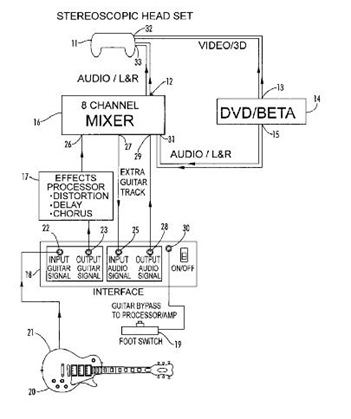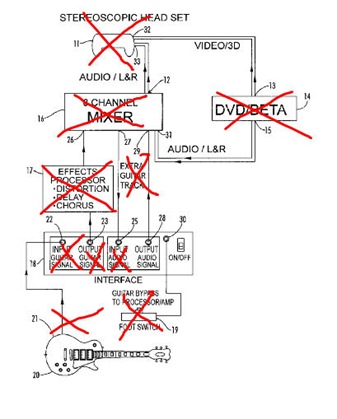Are you making music without real acoustic instruments? You know, in, like, virtual reality? Then you may have stepped into a strange, alternate dimension. Let’s call it, for the sake of argument, The Gibson Zone. They control the horizontal. They control the vertical. They invented what you’re doing … right now.
Or, at least, that seems to be the message sent by a recent patent dispute between Gibson Guitar Corporation and Guitar Hero developer Activision. (Harmonix, the original Guitar Hero developer, has moved on to Rock Band.)
I know what you’re thinking: maybe Gibson claims to have invented the guitar, or the Guitar Hero controller looks a little too much like an Epiphone or something. Ah, but that might actually make some sort of logical sense, and this is the topsy-turvy world of intellectual property. In fact, both Harmonix and Activision already have licenses with Gibson for their guitars.
Instead, Gibson is arguing they own the rights to anything that can “simulate participation in a concert,” which they patented in 1999. (Look out, air guitar lovers.) Now, I don’t claim to be an expert in patent law, but being the layperson that I am, I would assume the original Gibson patent would have some passing similarity to Guitar Hero.
System and method for generating and controlling a simulated musical concert experience [Google Patents]
Well, let’s review. The Gibson patent is described as follows:
“A musician can simulate participation in a concert by playing a musical instrument…”
Okay, with you so far.
“…and wearing a head-mounted 3D display that includes stereo speakers.”
Nope. Lost. They do know that Guitar Hero is not available for Virtual Boy, right?
“the musical instrument generating an instrument audio signal at an instrument audio output, the instrument audio signal varying in response to operation of the instrument by the user of the system;”
Okay: musical instrument, check. “Instrument audio signal?” No, not in Guitar Hero.
“a video source providing a source video signal at a source video output, the source video signal representing a video portion of the pre-recorded musical performance
a video display responsive to the source video signal whereby the user can view the video portion of the pre-recorded musical performance on the video display.”
To the extent that Guitar Hero involves a TV, yes. Pre-recorded musical performance? What? I’m lost again. In fact, what exactly is Gibson describing here? Playing your guitar while watching an old Pearl Jam concert DVD? With goggles on your eyes?
“an audio source providing a source audio signal at a source audio output, the source audio signal representing an audio portion of the pre-recorded musical performance, the audio portion including an instrument sound track containing pre-recorded musical sounds that would be generated by the musical instrument in the pre-recorded musical performance”
At this point, I think Gibson is patenting sound itself. Or, at least, karaoke, which as I recall had already been invented in 1999.
a system interface device having a first audio input electrically connected to the instrument audio output, a second audio input electrically connected to the source audio output, and a first interface audio output;
More damning evidence, except for the fact that Guitar Hero doesn’t have an audio interface.
And, still more:
f. the system interface device including a source audio control circuit responsive to the instrument audio signal, whereby a characteristic of the source audio signal is controlled in response to operation of the musical instrument by the user to provide a controlled source audio signal at the first interface audio output; and
g. an audio playback transducer responsive to the controlled source audio signal such that the user can listen to the audio portion of the pre-recorded musical performance on the transducer, in synchronization with the video portion.
Back to my first theory. This, followed by lots of talk about audio signals and audio portions and “video disc machines” still seems to involve you playing your Pearl Jam DVD karaoke-style with a guitar. In other words, both wholly un-patentable, and wholly unrelated to Guitar Hero, an interactive game with computer-generated graphics and a controller with buttons not audio.
It’d be a bit like if the guy who invented the paperclip claimed patent rights for deep sea fishing. But, as I said, this is patent law — so that may be possible.
Now some visual evidence:
Keeping in mind that what you’re looking at involves audio signal, not the control input of a game controller, from that guitar, I’ve provided this marked-up version, removing the stuff not in Guitar Hero:
But Gibson does have a point. To the extent that Guitar Hero involves:
- sound
- image
- people pretending to be musicians
- something shaped like a guitar
- an on/off switch
…Guitar Hero is a dead-ringer, patent-violating copy of what they described in 1999. Then again, so is a group of stoners playing air guitar Pink Floyd to The Wizard of Oz.
‘Guitar Hero’ Subject of Patent Dispute [Associated Press, via Wired.com]



